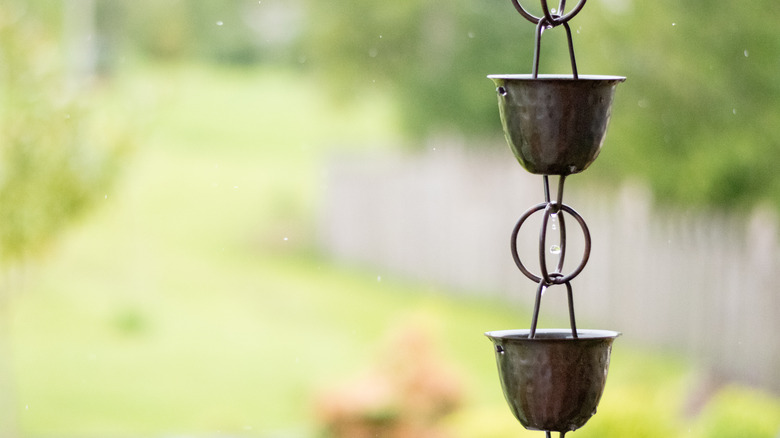Here's Why Your Rain Chain Isn't Working Properly
They're traditional, beautiful, and most importantly, functional. Rain chains are also steeped with history, according to Happy Gardens. These ornamental gutter alternatives can be traced back to mid 1550s Japan, where they were traditionally called kusari-doi. While rain chains are commonly seen adorning modern day residences, they're also frequently found in shrines, temples, and tea houses all over the island nation.
The main purpose of a rain chain is to prevent ground erosion caused by constant water dripping from a roof. Rainwater flows off the roof and into the downspout where the rain chain is attached along the eave or gutter of a house. The water runs down the chain and pools into a water catching vessel or an in-ground drain. While rain chains might seem simple enough to use, it's important to note that they can (and do) run into some issues from time to time. If your rain chain isn't working as it should, then it's time to do a visual inspection to check for any of the following potential issues.
There's too much rain
One of the nice things about a rain chain is that, as water delicately cascades down the apparatus, it produces a rather soothing waterfall sound reminiscent of a what you would want to hear in your own personal self-care zen zone. What's not so pleasant is when your kusari-doi produces more of an obnoxious splashing sound that is quite the opposite of tranquil.
If you live in an area that gets frequent or heavy rainfall, you could end up with some extra noisy rain chains, explains Valiant Exteriors. The way to get around this is by making sure your rain chain is securely fastened at the top where it's attached to the gutter, as well as securely anchored to the ground or a heavy base. This should also prevent your rain chain from sloshing or swaying during inclement weather. If the water's journey ends with a loud spattering, then you might also want to consider installing a splash pad, which will help to mute that undesirable sound.
The weather is too cold
There's a simple beauty in gazing outside your window and seeing that your rain chain has been frozen over and looks like a wintry stalactite. This could also be the reason why it's not working properly, and that's not just because it's become a rain chain popsicle. For the most part, rain chains are designed to withstand the elements, but they're still fragile and breakable. That's another reason why it's important to make sure that yours is securely fastened to the gutter drain at the top. Colorado Seamless Gutters advises that a U bolt is the safest and securest method of attachment. Water expands when it freezes, so as it flows down your rain chain, you risk damaging both the water catching vessel and the actual links themselves.
A frozen rain chain might also cause damage to the points where it's attached. This means that once spring rolls around, you'll have to grab a ladder and fix not only the gutter, but the actual rain chain itself. Otherwise, you can spend the money and call in gutter cleaning professionals. That being said, depending on the quality and craftsmanship of your rain chain, it should withstand regular ice and snow. Of course, it's best to err on the side of caution and take it down once the weather begins to dip into frigid temperatures.
Your rain chain is clogged
Just like the gutters on your house, it's important to routinely inspect and properly maintain your rain chain to make sure it's working as efficiently as possible. These functional works of art are designed to allow maximum water flow (just like gutters), but it's not unheard of for leaves or other debris from nature to get caught inside the vessels by way of wind or from the attached gutter itself, per SEO Rain Chains.
If your rain chain appears to be pooling or overflowing from one or more of its water-catching receptacles, then it might be due for a cleaning. It's recommended that you clean your rain chain at least once a year to keep it from getting clogged and sluggish. To keep your rain chain as debris-free as possible, consider hanging it in a spot away from the trees most likely to shed leaves onto the roof of your home.



